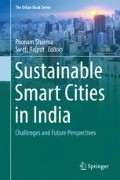Abstract
Buildings are a major energy consuming sector in the economy. About 35–40% of total energy is used by buildings during construction. The major consumption of Energy in buildings is during construction and later in lighting or air conditioning systems. This consumption must be minimized. Buildings affect land use, energy use, communities and the indoor and outdoor environment. In today’s scenario, one of the tools in creating Smart city is Green Building or Sustainable building. Green building is the practice of designing, constructing, operating, maintaining, renovating and demolishing buildings in ways that conserve natural resources, reduce pollution and are environmentally responsible. Green building concept is expanding around the world. Use of sustainable principles in buildings can reduce these impacts and also improve working conditions and productivity, increase energy, water, and material efficiency and reduce costs and risks. Sustainable buildings can be showcases to educate people about environmental issues, possible solutions, partnerships, creativity and opportunities for reducing environmental impacts in our everyday lives. Successful green buildings leave lighter footprints on the environment through conservation of resources. In other words, green building design involves finding the delicate balance between homebuilding and a sustainable environment. In the developing countries like India, poverty alleviation can be effectively achieved by conservation of energy and creation of employment opportunities.
Access this chapter
Tax calculation will be finalised at checkout
Purchases are for personal use only
Abbreviations
- BREEAM:
-
Building research establishment environmental assessment method
- CASBEE:
-
Comprehensive assessment system for building environmental efficiency
- EPA:
-
Environmental Protection Agency
- GRIHA:
-
Green rating for integrated habitat assessment
- HVAC:
-
Heating, ventilation and air conditioning
- IAQ:
-
Indoor air quality
- IEQ:
-
Indoor environmental quality
- IGBC:
-
Indian Green Building Council
- LEED:
-
Leadership in energy and environmental design
- MoEF:
-
Ministry of Environment and Forests
- NABERS:
-
National Australian Built Environment Rating System
- NSW:
-
New South Wales
- O&M:
-
Operations and maintenance
- TERI:
-
The Energy and Research Institute
- USGBC:
-
United States Green Building Council
- VOC’s:
-
Volatile organic compounds
References
Barry JA (2007) Watergy: energy and water efficiency in municipal water supply and waste waste treatment, cost effective savings water and energy. Handbook: alliance to save energy, Washington DC
Buchanan AH, Levine SB (1999) Wood-based building materials and atmospheric carbon emissions. Environ Sci Policy 2:427–437
California Integrated Waste Management Board (2009) Green building home page. http://www.ciwmb.ca.gov/GREENBUILDING/basics.html. Accessed 28 Nov 2009
Hegazy T (2002) Computer-based construction project management. Prentice Hall, New Jersey
Hopkins R (2002) A natural way of building. transition culture. http:/transitionculture.org/article/a-natural-way-of-building-2002/. Retrieved 30 Mar 2007
Kats G, Leon A, Adam B, Evan M, Jeff P (2003) The cost and financial benefits of green buildings: a report to California’s sustainable building task force
Kennedy JF (1999) The art of natural building: design, construction, technology. Networks Productions, Kingston
Lange J, Grottker M, Otterpohl R (1997) Sustainable water and waste management in urban areas. WaterSciTechnol 35:121–133
Pushkar S, Becker R, Katz A (2005) A methodology for design of environmentally optimal buildings by variable grouping. Build Environ 40:1126–1139
Ramesh SP, Khan ME (2013) Energy efficiency in green buildings—Indian concept. I J Emerg Tech Adv Eng 3:329–336
Shrinivas S (2005) Green building movement in India by principal counselor, CII—Sohrabji Godrej green Business Centre
Simpson JR (2002) Improved Estimates of tree-shade effects on residential energy use. Energy Build 34:1067–1076
Spiegel R, Meadows D (1999) Green building materials: a guide to product selection and specification. Wiley, New York
U.S. Environmental Protection Agency (2009) Green building basic information. http://www.epa.gov/greenbuilding/pubs/about.html Accessed 10 Dec 2009
U.S. Environmental Protection Agency (2014) Green building materials. http://www.epa.gov/greenbuilding/pubs/components.html Retrieved 28 Nov 2009
World Bank (2001) China: opportunities to energy efficiencies in building, Washington DC
Author information
Authors and Affiliations
Corresponding author
Editor information
Editors and Affiliations
Rights and permissions
Copyright information
© 2017 Springer International Publishing AG
About this chapter
Cite this chapter
Srivastava, A., Singh, P., Janhavi, N.N., Singh, A. (2017). Green Buildings: Eco-friendly Technique for Modern Cities. In: Sharma, P., Rajput, S. (eds) Sustainable Smart Cities in India. The Urban Book Series. Springer, Cham. https://doi.org/10.1007/978-3-319-47145-7_26
Download citation
DOI: https://doi.org/10.1007/978-3-319-47145-7_26
Published:
Publisher Name: Springer, Cham
Print ISBN: 978-3-319-47144-0
Online ISBN: 978-3-319-47145-7
eBook Packages: Earth and Environmental ScienceEarth and Environmental Science (R0)

